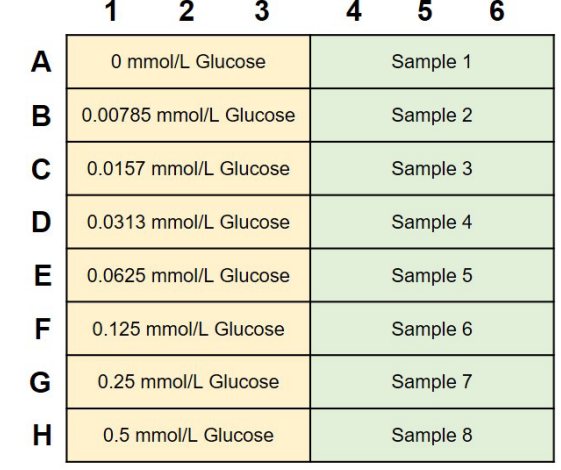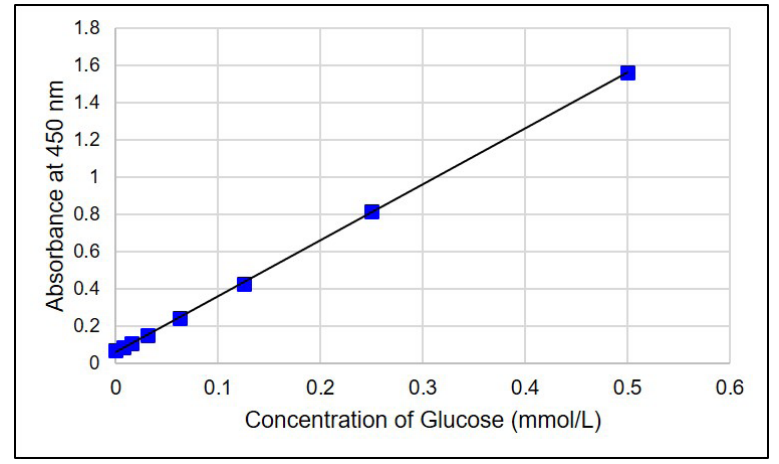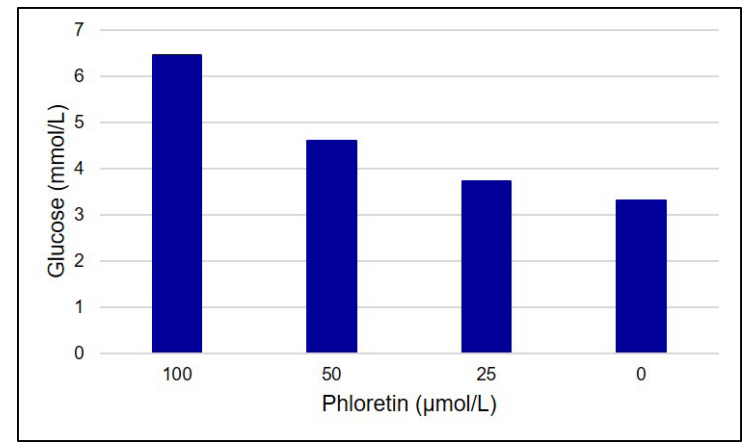General Information
Glucose, the most important biological energy source, is a known marker for energy metabolism. It is used not only as a marker for diabetes and obesity but also for monitoring changes in intracellular metabolism, such as lactate production. In addition, a recent study suggested that inhibition of the enzymatic activities involved in both glucose and lipid metabolism effectively inhibits cancer cell proliferation1).
Glucose Assay Kit-WST enables quantitation of glucose as a substrate in energy metabolism. This kit has been optimized to quantify glucose in cell culture supernatants by measuring absorbance in a colorimetric WST reaction. This kit is formatted for 96-well microplates and the assay has a detection limit of 0.02 mmol/L glucose.

Figure 1. Principle of Glucose Assay Kit-WST
Kit Contents
| 50 tests | 200 tests | |
| Dye Mixture | x 1 | x 1 |
| Glucose Standard (10 mmol/L) (Red cap) | 150 μL x 1 | 600 μL x 1 |
| Enzyme (Green cap) | x 1 | x 1 |
| Assay Buffer | 3.5 mL x 1 | 14 mL x 1 |
| Reconstitution Buffer (Blue cap) | 350 μL x 1 | 1.4 mL x 1 |
Storage Conditions
Store at 0-5 °C
Required Equipment and Materials
-
- Microplate reader (450 nm filter)
- Incubator (37 °C)
- 100-1000 μL and 20-200 μL micropipettes
- Conical tube
-
- 96-well microplate
- 20-200 μL multichannel pipette
- Phosphate buffered saline (PBS)
- 0.1% Triton X-100
Precautions
- Equilibrate reagents to room temperature prior to use.
- Centrifuge the tube with Enzyme (green cap) briefly before opening to remove all content from walls of the tube and inside the cap.
- Analyzing samples and standards in triplicate is recommended for accuracy.
- Use a multichannel pipette to dispense working solution, to minimize time lag in pipetting, because the enzymatic reaction is initiated immediately upon its addition.
- Prepare samples at different dilutions to determine the most suitable concentration, ranging from 0 to 0.5 mmol/L glucose.
- Dye Mixture is stored in a glass bottle with an aluminum cap. Handle with caution, wearing gloves.
- The kit was designed for analyzing cell culture supernatants. To instead measure intracellular glucose, prepare cell lysates and glucose standards in a 0.1% Triton X-100 solution.
Preparation of Solutions
Preparation of Dye Mixture stock solution
Add the entire volume of Reconstitution Buffer to the Dye Mixture vial and dissolve contents completely.
- Transfer the resulting Dye Mixture stock solution to the vial from the Reconstitution Buffer and store at 0-5 °C, protected from light.
The Dye Mixture stock solution is stable for 2 months under these conditions.
Preparation of Enzyme stock solution
Add PBS to the Enzyme tube and dissolve with pipetting.
- Refer to Table 1.
- Centrifuge the tube briefly each time before opening to remove all content from the tube wall or inside the cap.
- Enzyme stock solution should be maintained in an ice bath during use.
- The Enzyme stock solution is stable for 2 months when stored at 0-5 °C.
| 50 tests | 200 tests | |
| The volume of PBS | 65 µL | 260 µL |
Preparation of working solution
- Add the Dye Mixture stock solution to a conical tube and dilute with Assay Buffer.
- Add the Enzyme stock solution to the solution prepared in step (1).
- Refer to Table 2.
- The working solution is light-sensitive. Prepare it immediately prior to use and protect it from light by covering the tube with aluminum foil. Prepare working solution fresh each day.
| for 24 well | for 48 well | for 96 well | |
| Dye Mixture stock solution | 150 μL | 300 μL | 600 μL |
| Assay Buffer | 1.35 mL | 2.7 mL | 5.4 mL |
| Enzyme stock solution | 27 μL | 54 μL | 108 μL |
General Protocol
1. Sample preparation
Prepare cell culture supernatants (samples).
- Prepare samples at different dilutions to determine the most suitable concentration. Glucose concentrations should range from 0 to 0.5 mmol/L. Use double-deionized H2O (ddH2O) for dilutions.
- Sample volume in the assay is 50 μL per well.
2. Preparation of glucose standard solution
Mix 50 μL Glucose Standard (10 mmol/L) and 950 μL ddH2O in a microtube to prepare a 0.5 mmol/L glucose standard solution. Serially dilute with ddH2O to prepare 0.5, 0.25, 0.125, 0.0625, 0.0313, 0.0157, 0.00785, and 0 mmol/L (Figure 2).
- To measure intracellular glucose concentrations, prepare glucose standard solutions in 0.1% Triton X-100 instead of ddH2O.

Figure 2. Preparation of glucose standard solutions
3. Measurements
- Add 50 μL glucose standard and sample solutions to separate wells in the 96-well microplate (Figure 3).
- To obtain accurate data, triplicate samples are recommended.
- Add 50 μL working solution to each well.
- Because the enzymatic reaction starts immediately after working solution is added, it should be dispensed with a multichannel pipette to minimize time lags in pipetting.
- Incubate the microplate at 37 °C for 30 minutes.
- Seal the microplate during incubation to prevent evaporation.
- Measure absorbance at 450 nm with a microplate reader.
- Calculate the glucose concentration in each sample from a calibration curve generated from the glucose standards.
- Multiply the results by the dilution factor to determine glucose concentrations in the original samoles.

Figure 3. Example of an assay plate format (n=3)

Figure 4. Typical calibration curve generated with glucose standards
Experimental Example
Inhibition of glucose uptake by phloretin
- Jurkat cells (5×105 cells/mL, in RPMI containing 10% fetal bovine serum and 1% penicillin-streptomycin) were suspended in medium containing phloretin.
- The cells prepared in step 1. were seeded in a 6-well microplate (1×106 cells/well) and cultured overnight at 37 °C in a 37 °C incubator equilibrated with 95% air, 5% CO2.
- After the incubation, the cell suspension was transferred to a conical tube and centrifuged at 300×g for 5 minutes.
- The supernatant (100 μL) was transferred to a 1.5 mL microtube and diluted 30-fold with ddH2O (sample solution). Sample or glucose standard solutions, -50 μL each, were added to individual wells of 96-well micro plate.
- Working solution (50 μL) was added to each well.
- The assay plate was incubated at 37 °C for 30 minutes.
- Absorbance at 450 nm was measured with a microplate reader and the concentrations of glucose in the samples were calculated from the calibration curve.

Figure 5. Inhibition of glucose uptake by phloretin
Decreased glucose consumption in accordance with the concentration of phloretin, a glucose transport inhibitor, was confirmed.
Reference
- Xiaoping, Z. et al., J. Biol. Chem., 2018, 293, 6623-6634.
Frequently Asked Questions / Reference
G264: Glucose Assay Kit-WST
Revised Sep., 14, 2023


 Hidden sections will not be printed.
Hidden sections will not be printed.